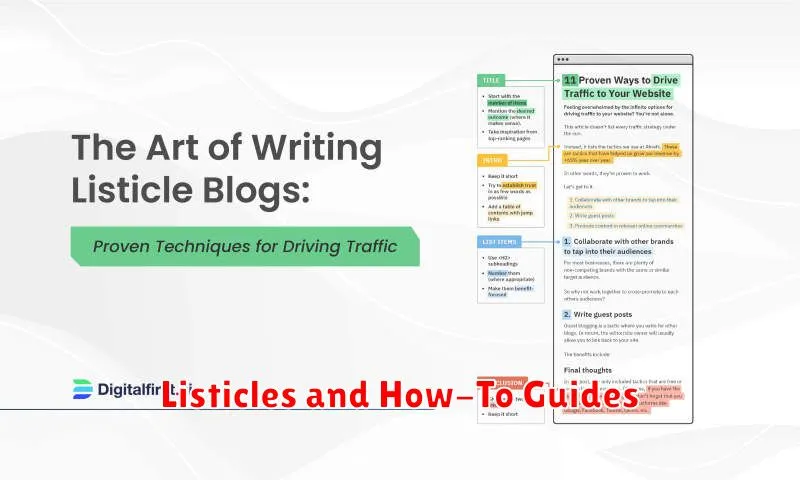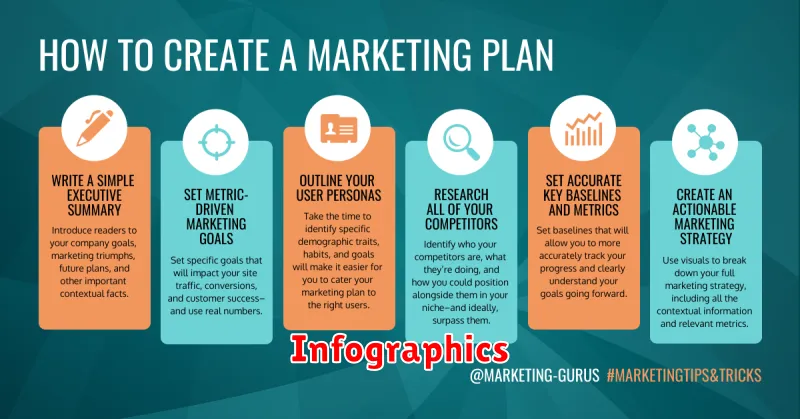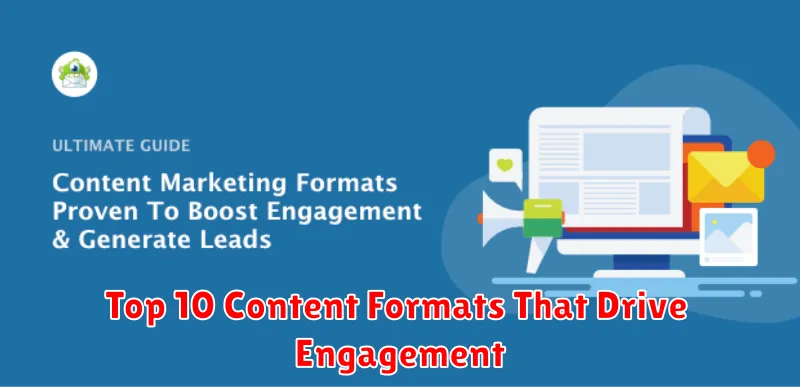In today’s digital landscape, creating engaging content is crucial for any successful online presence. Whether you’re a business aiming to boost brand awareness, a marketer seeking to drive conversions, or a content creator striving to build a loyal audience, understanding the most effective content formats is essential. Content engagement drives traffic, fosters community, and ultimately contributes to achieving your online objectives. This article explores the top 10 content formats that drive engagement, providing valuable insights into leveraging these formats to maximize your impact.
From captivating videos and interactive quizzes to informative blog posts and visually appealing infographics, the possibilities for content formats are vast. Selecting the right format for your target audience and message is key to achieving high levels of content engagement. By exploring these top 10 content formats, you can discover innovative approaches to capture attention, encourage interaction, and cultivate a thriving online community. This exploration of the top 10 content formats that drive engagement will empower you to create content that resonates with your audience and delivers exceptional results.
Listicles and How-To Guides

Listicles and how-to guides are highly effective content formats for driving engagement. They offer easily digestible information, presented in a structured and organized manner. This format caters to the modern reader’s preference for quick consumption of information.
Listicles, numbered lists of items or ideas, appeal to readers due to their scannable nature. They offer a clear overview of the content at a glance. Listicles can cover a broad range of topics, from “Top 10 Tips for…” to “5 Ways to Improve…”.
How-to guides provide step-by-step instructions on completing a specific task or achieving a particular goal. Their practical nature makes them highly valuable to readers seeking solutions and guidance. The clear, concise language used in how-to guides ensures readers can follow the instructions easily.
Both formats benefit from the use of strong headings, bullet points, and numbered lists, which contribute to readability and overall engagement.
Infographics

Infographics present complex information in a visually appealing and easily digestible format. They combine data visualization, design, and storytelling to engage audiences and enhance understanding of a particular topic.
Key benefits of using infographics include improved comprehension, increased shareability on social media platforms, and enhanced brand visibility. They are effective for simplifying intricate data, explaining processes, and highlighting key trends.
Creating effective infographics requires careful planning and execution. Consider the following:
- Target audience: Tailor the design and content to resonate with your specific audience.
- Data accuracy: Ensure the information presented is accurate and reliable.
- Visual appeal: Use compelling visuals, clear typography, and a logical flow to guide the reader.
Short-Form Video Content
In today’s fast-paced digital landscape, short-form video content has emerged as a dominant force. Platforms like TikTok, Instagram Reels, and YouTube Shorts have capitalized on the shrinking attention spans of users, offering easily digestible content that can be consumed in seconds.
Engagement is paramount with this format. The quick, impactful nature of short videos encourages likes, shares, comments, and overall interaction. Creators utilize trending audio, captivating visuals, and concise storytelling to hook viewers from the start.
Brevity is key. Videos typically range from a few seconds to a minute, requiring creators to deliver their message efficiently. This condensed format demands creativity and precision.
Discoverability is another advantage. Short-form video platforms often employ powerful algorithms that push content to a wide audience, increasing the potential for viral reach and brand exposure.
Podcasts and Audio Clips
Podcasts and shorter audio clips are gaining immense popularity as a content format. They offer a convenient way for audiences to consume information while multitasking, commuting, or exercising. Accessibility is a key advantage, requiring only a smartphone or other listening device. This format is ideal for in-depth discussions, interviews, storytelling, and sharing expertise.
Key benefits of podcasts and audio clips include:
- Convenience: Consumable on the go.
- Engagement: Creates a personal connection with listeners.
- Versatility: Suitable for various content types.
- Cost-effectiveness: Relatively inexpensive to produce.
Consider incorporating audio clips into your content strategy to reach a wider audience and provide an alternative format for consuming valuable information.
Webinars and Live Sessions
Webinars and live sessions offer a dynamic and engaging way to connect with your audience in real-time. These formats provide a platform for in-depth discussions, expert presentations, and interactive Q&A sessions.
Key Benefits:
- High Engagement: Live interaction fosters a sense of community and encourages active participation.
- Lead Generation: Registration requirements provide valuable lead capture opportunities.
- Thought Leadership: Positioning your brand as an authority in your industry.
- Direct Interaction: Addressing audience questions and concerns instantly builds trust and rapport.
Best Practices:
- Promote your webinar or live session effectively to maximize attendance.
- Choose a compelling topic relevant to your audience’s interests.
- Keep the presentation concise and focused, incorporating visuals and interactive elements.
- Follow up with attendees post-session with recordings and additional resources.
User-Generated Content
User-generated content (UGC) leverages the authenticity of customer experiences to promote a brand. It comes directly from users, in the form of reviews, testimonials, photos, videos, and social media posts.
UGC builds trust and credibility. Potential customers often value the opinions of their peers more than branded marketing messages. This organic content feels more genuine and less promotional.
Benefits of incorporating UGC include increased engagement, expanded reach through social sharing, and valuable insights into customer preferences. It also provides cost-effective content creation, as the users are doing the work.
Examples include encouraging customers to share photos of their product experiences on social media with a branded hashtag, incorporating customer reviews onto product pages, or featuring user-submitted videos in marketing campaigns.
Case Studies and Whitepapers
Case studies and whitepapers offer in-depth explorations of specific topics, providing valuable insights and establishing your organization as a thought leader. Case studies showcase real-world applications and successes, demonstrating the practical value of your product or service. They often feature data, metrics, and testimonials to build credibility and trust.
Whitepapers delve into complex issues, offering comprehensive analysis and expert perspectives. They are typically longer and more detailed than case studies, focusing on educating the audience about a particular subject matter. Whitepapers can effectively position your brand as a trusted source of information and generate leads by requiring contact information for access.
Email Newsletters
Email newsletters are a direct line of communication to your audience, fostering a sense of community and loyalty. They offer a platform to deliver valuable content directly to subscribers’ inboxes, keeping them informed and engaged.
Key Benefits:
- Targeted Reach: Deliver tailored messages to specific segments of your audience based on their interests and preferences.
- Increased Engagement: Provide exclusive content, promotions, and updates to nurture relationships and encourage repeat visits.
- Drivable Traffic: Promote new content or products and guide subscribers back to your website or platform.
- Measurable Results: Track key metrics such as open rates, click-through rates, and conversions to analyze effectiveness and refine your strategy.
Newsletters can feature a variety of content formats, including curated articles, company updates, product announcements, and exclusive offers. Consistency is key to maintaining subscriber engagement and maximizing the impact of email newsletters.
Polls and Interactive Quizzes

Polls and interactive quizzes offer a dynamic way to engage your audience. They encourage active participation and provide immediate feedback, fostering a sense of community and making learning more enjoyable.
Polls are simple and effective tools for gathering opinions and preferences quickly. They can be used to gauge audience sentiment on a particular topic, gain insights into their needs, or even just for fun, lighthearted interactions. This real-time feedback can be invaluable for tailoring future content and understanding your audience better.
Interactive quizzes take engagement a step further by testing knowledge and providing a more immersive experience. They can be designed to be educational, entertaining, or a blend of both. Quizzes can be used to reinforce learning, assess comprehension, or simply offer a fun challenge. The interactive format and element of competition can be highly motivating for users.
Carousel Posts on Social Media
Carousel posts offer a dynamic way to present multiple pieces of information within a single post. They allow users to swipe through various images or videos, each with its own caption or description. This format is highly engaging as it encourages interaction and provides a richer storytelling experience compared to static single-image posts.
Key benefits of carousel posts include showcasing product variations, telling a step-by-step process, or highlighting different features of a product or service. Think of them as mini presentations packaged within your social media feed.
Best practices for creating effective carousels include using high-quality visuals, keeping captions concise and informative, and using a clear call to action on the final slide to drive desired user behavior.

